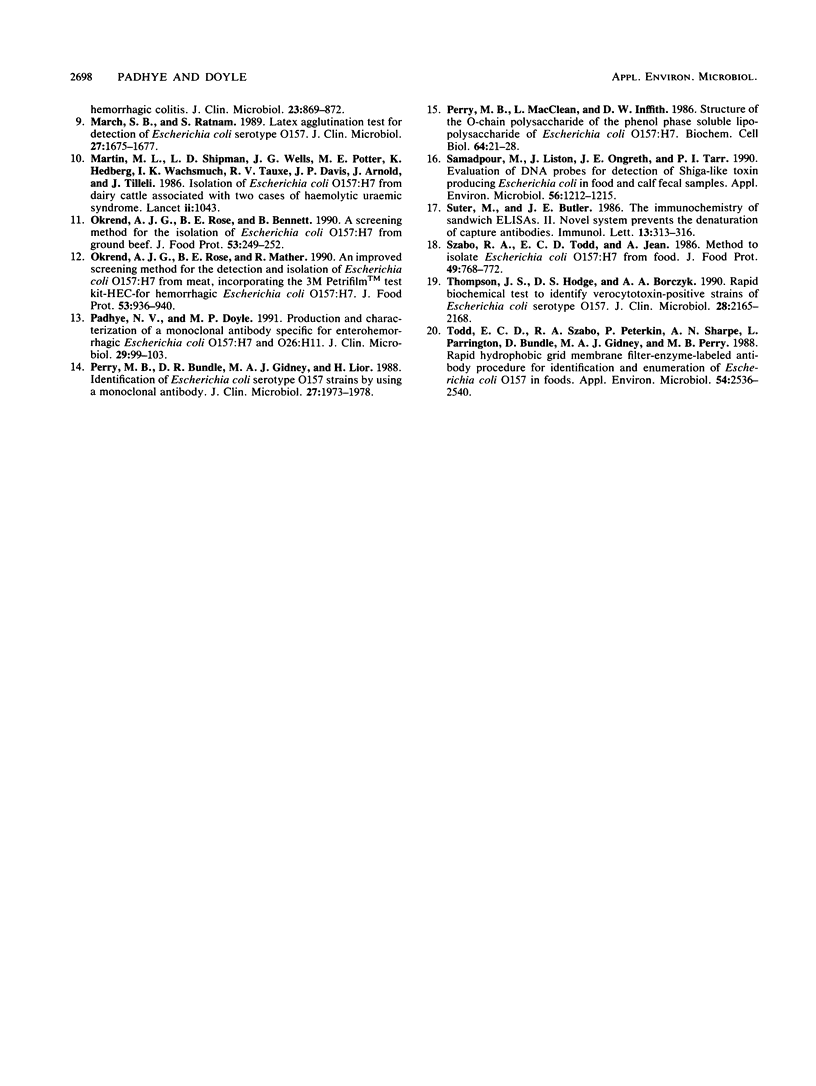Abstract
A sensitive, specific procedure was developed for detecting Escherichia coli O157:H7 in food in less than 20 h. The procedure involves enrichment of 25 g of food in 225 ml of a selective enrichment medium for 16 to 18 h at 37 degrees C with agitation (150 rpm). The enrichment culture is applied to a sandwich enzyme-linked immunosorbent assay (ELISA) with a polyclonal antibody specific for E. coli O157 antigen as the capture antibody and a monoclonal antibody specific for enterohemorrhagic E. coli of serotypes O157:H7 and O26:H11 as the detection antibody. The ELISA can be completed within 3 h. The sensitivity of the procedure, determined by using E. coli O157:H7-inoculated ground beef and dairy products, including different varieties of cheese, was 0.2 to 0.9 cell per g of food. A survey of retail fresh ground beef and farm raw milk samples with this procedure revealed that 3 (2.8%) of 107 ground beef samples and 11 (10%) of 115 raw milk samples were positive for E. coli O157:H7. Most-probable-number determinations revealed E. coli O157:H7 populations of 0.4 to 1.5 cells per g in the three ground beef samples. In addition to being highly specific, sensitive, and rapid, this procedure is easy to perform and is amenable to use by laboratories performing routine microbiological testing.
Full text
PDF





Selected References
These references are in PubMed. This may not be the complete list of references from this article.
- Borczyk A. A., Karmali M. A., Lior H., Duncan L. M. Bovine reservoir for verotoxin-producing Escherichia coli O157:H7. Lancet. 1987 Jan 10;1(8524):98–98. doi: 10.1016/s0140-6736(87)91928-3. [DOI] [PubMed] [Google Scholar]
- Doyle M. P., Schoeni J. L. Isolation of Escherichia coli O157:H7 from retail fresh meats and poultry. Appl Environ Microbiol. 1987 Oct;53(10):2394–2396. doi: 10.1128/aem.53.10.2394-2396.1987. [DOI] [PMC free article] [PubMed] [Google Scholar]
- Doyle M. P., Schoeni J. L. Survival and growth characteristics of Escherichia coli associated with hemorrhagic colitis. Appl Environ Microbiol. 1984 Oct;48(4):855–856. doi: 10.1128/aem.48.4.855-856.1984. [DOI] [PMC free article] [PubMed] [Google Scholar]
- Karmali M. A. Infection by verocytotoxin-producing Escherichia coli. Clin Microbiol Rev. 1989 Jan;2(1):15–38. doi: 10.1128/cmr.2.1.15. [DOI] [PMC free article] [PubMed] [Google Scholar]
- Kleanthous H., Fry N. K., Smith H. R., Gross R. J., Rowe B. The use of sorbitol-MacConkey agar in conjunction with a specific antiserum for the detection of Vero cytotoxin-producing strains of Escherichia coli O 157. Epidemiol Infect. 1988 Oct;101(2):327–335. doi: 10.1017/s0950268800054261. [DOI] [PMC free article] [PubMed] [Google Scholar]
- Levine M. M., Xu J. G., Kaper J. B., Lior H., Prado V., Tall B., Nataro J., Karch H., Wachsmuth K. A DNA probe to identify enterohemorrhagic Escherichia coli of O157:H7 and other serotypes that cause hemorrhagic colitis and hemolytic uremic syndrome. J Infect Dis. 1987 Jul;156(1):175–182. doi: 10.1093/infdis/156.1.175. [DOI] [PubMed] [Google Scholar]
- March S. B., Ratnam S. Latex agglutination test for detection of Escherichia coli serotype O157. J Clin Microbiol. 1989 Jul;27(7):1675–1677. doi: 10.1128/jcm.27.7.1675-1677.1989. [DOI] [PMC free article] [PubMed] [Google Scholar]
- Martin M. L., Shipman L. D., Wells J. G., Potter M. E., Hedberg K., Wachsmuth I. K., Tauxe R. V., Davis J. P., Arnoldi J., Tilleli J. Isolation of Escherichia coli O157:H7 from dairy cattle associated with two cases of haemolytic uraemic syndrome. Lancet. 1986 Nov 1;2(8514):1043–1043. doi: 10.1016/s0140-6736(86)92656-5. [DOI] [PubMed] [Google Scholar]
- Padhye N. V., Doyle M. P. Production and characterization of a monoclonal antibody specific for enterohemorrhagic Escherichia coli of serotypes O157:H7 and O26:H11. J Clin Microbiol. 1991 Jan;29(1):99–103. doi: 10.1128/jcm.29.1.99-103.1991. [DOI] [PMC free article] [PubMed] [Google Scholar]
- Perry M. B., MacLean L., Griffith D. W. Structure of the O-chain polysaccharide of the phenol-phase soluble lipopolysaccharide of Escherichia coli 0:157:H7. Biochem Cell Biol. 1986 Jan;64(1):21–28. doi: 10.1139/o86-004. [DOI] [PubMed] [Google Scholar]
- Samadpour M., Liston J., Ongerth J. E., Tarr P. I. Evaluation of DNA probes for detection of Shiga-like-toxin-producing Escherichia coli in food and calf fecal samples. Appl Environ Microbiol. 1990 May;56(5):1212–1215. doi: 10.1128/aem.56.5.1212-1215.1990. [DOI] [PMC free article] [PubMed] [Google Scholar]
- Suter M., Butler J. E. The immunochemistry of sandwich ELISAs. II. A novel system prevents the denaturation of capture antibodies. Immunol Lett. 1986 Nov 3;13(6):313–316. doi: 10.1016/0165-2478(86)90064-7. [DOI] [PubMed] [Google Scholar]
- Thompson J. S., Hodge D. S., Borczyk A. A. Rapid biochemical test to identify verocytotoxin-positive strains of Escherichia coli serotype O157. J Clin Microbiol. 1990 Oct;28(10):2165–2168. doi: 10.1128/jcm.28.10.2165-2168.1990. [DOI] [PMC free article] [PubMed] [Google Scholar]
- Todd E. C., Szabo R. A., Peterkin P., Sharpe A. N., Parrington L., Bundle D., Gidney M. A., Perry M. B. Rapid hydrophobic grid membrane filter-enzyme-labeled antibody procedure for identification and enumeration of Escherichia coli O157 in foods. Appl Environ Microbiol. 1988 Oct;54(10):2536–2540. doi: 10.1128/aem.54.10.2536-2540.1988. [DOI] [PMC free article] [PubMed] [Google Scholar]


